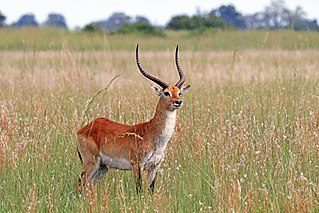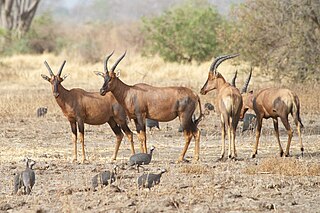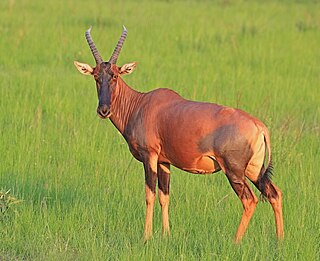
The hirola, also called the Hunter's hartebeest or Hunter's antelope, is a critically endangered antelope species found on the border between Kenya and Somalia. It was first described by the big game hunter and zoologist H.C.V. Hunter in 1888. It is the only living member of the genus Beatragus, though other species are known from the fossil record. The global hirola population is estimated at 300–500 animals and there are none in captivity. According to a document produced by the International Union for Conservation of Nature "the loss of the hirola would be the first extinction of a mammalian genus on mainland Africa in modern human history".

The common tsessebe or sassaby is the southern, nominate subspecies of Damaliscus lunatus, although some authorities have recognised it as an independent species. It is most closely related to the Bangweulu tsessebe, sometimes also seen as a separate species, less to the topi, korrigum, coastal topi and tiang subspecies of D. lunatus, and less to the bontebok in the same genus. Common tsessebe are found in Angola, Zambia, Namibia, Botswana, Zimbabwe, Eswatini, and South Africa.

The hartebeest, also known as kongoni or kaama, is an African antelope. It is the only member of the genus Alcelaphus. Eight subspecies have been described, including two sometimes considered to be independent species. A large antelope, the hartebeest stands just over 1 m at the shoulder, and has a typical head-and-body length of 200 to 250 cm. The weight ranges from 100 to 200 kg. It has a particularly elongated forehead and oddly-shaped horns, a short neck, and pointed ears. Its legs, which often have black markings, are unusually long. The coat is generally short and shiny. Coat colour varies by the subspecies, from the sandy brown of the western hartebeest to the chocolate brown of the Swayne's hartebeest. Both sexes of all subspecies have horns, with those of females being more slender. Horns can reach lengths of 45–70 cm (18–28 in). Apart from its long face, the large chest and the sharply sloping back differentiate the hartebeest from other antelopes. A conspicuous hump over the shoulders is due to the long dorsal processes of the vertebrae in this region.

The lechwe, red lechwe, or southern lechwe is an antelope found in wetlands of south-central Africa.

Weyns's duiker is a tiny antelope found in the Democratic Republic of Congo, Uganda and western Kenya. It is sometimes spelled "Weyn's", "Weyns", or "Weyns'" duiker.

The korrigum, also known as Senegal hartebeest, is a subspecies of the topi, a large African antelope.

Damaliscus lunatus is a large African antelope of the genus Damaliscus and subfamily Alcelaphinae in the family Bovidae, with a number of recognised geographic subspecies. Some authorities have split the different populations of the species into different species, although this is seen as controversial. Common names include topi, sassaby, tiang and tsessebe.

Damaliscus lunatus jimela is a subspecies of topi, and is usually just called a topi. It is a highly social and fast type of antelope found in the savannas, semi-deserts, and floodplains of sub-Saharan Africa.

The Bangweulu tsessebe is a population and possible taxon of Damaliscus lunatus, which are large African antelopes of the grasslands. This population is presently restricted to northern Zambia in the wild, although it was recorded as occurring in neighbouring southernmost Democratic Republic of the Congo in the 1940s. Also seen as the northernmost population belonging to the nominate southern sassaby subspecies, in 2003 it was described as a new species, only to be downgraded to a subspecies a few years later. Its taxonomic status is unclear as of 2021. As an individual sassaby of this taxon cannot be clearly distinguished from populations to the south, the taxon was defined using an experimental suite of statistical techniques applied to a sample set, based on multivariate analysis, and recognised under an experimental new taxonomy. Nominate sassaby antelopes become progressively darker on average in the northern populations, and on average have a slightly thicker horns at the base of the skull, but those of northern Zambia are the darkest and with the most robust horns on average.
The tiang is a subspecies of the topi, an African antelope.








